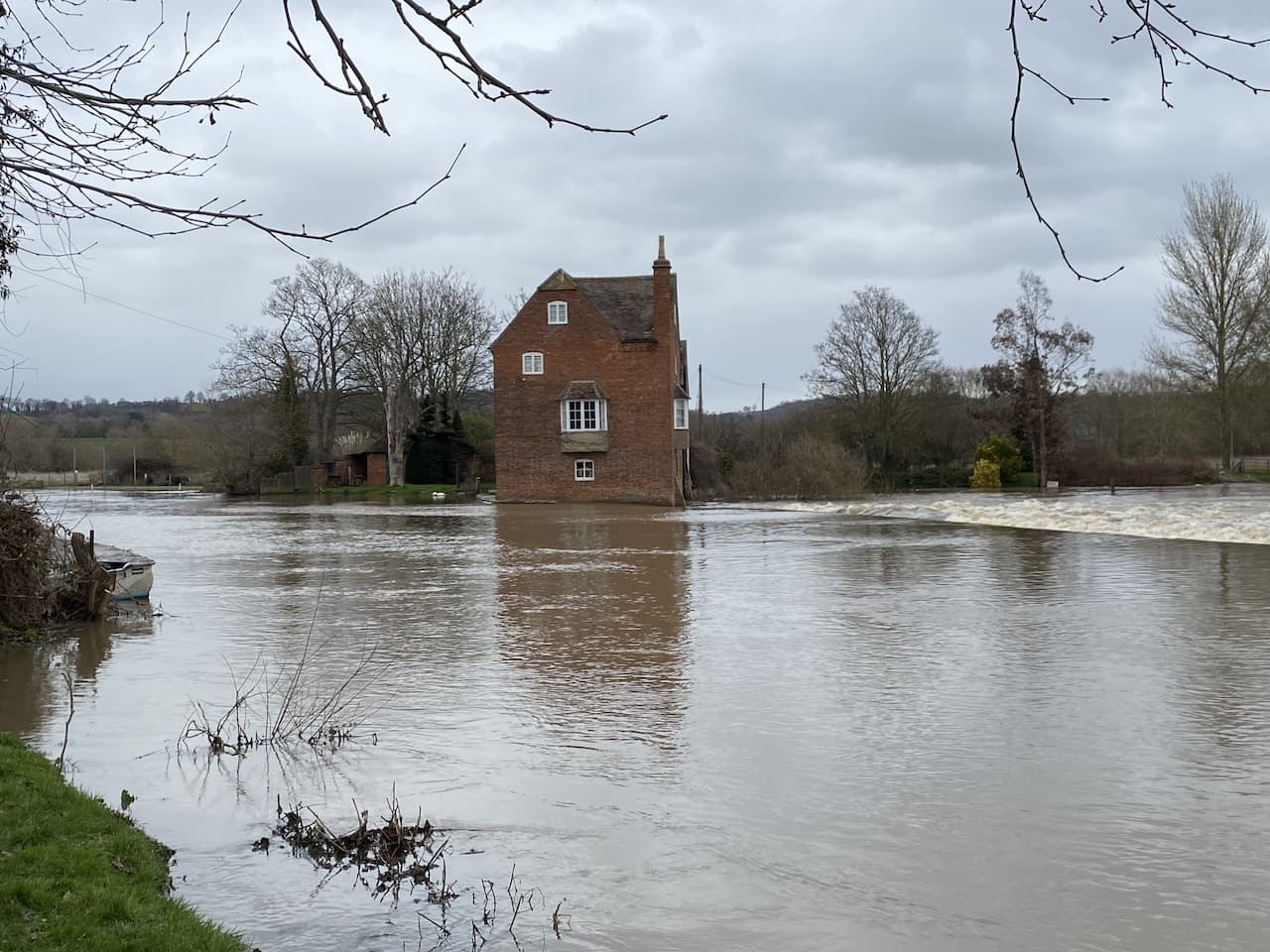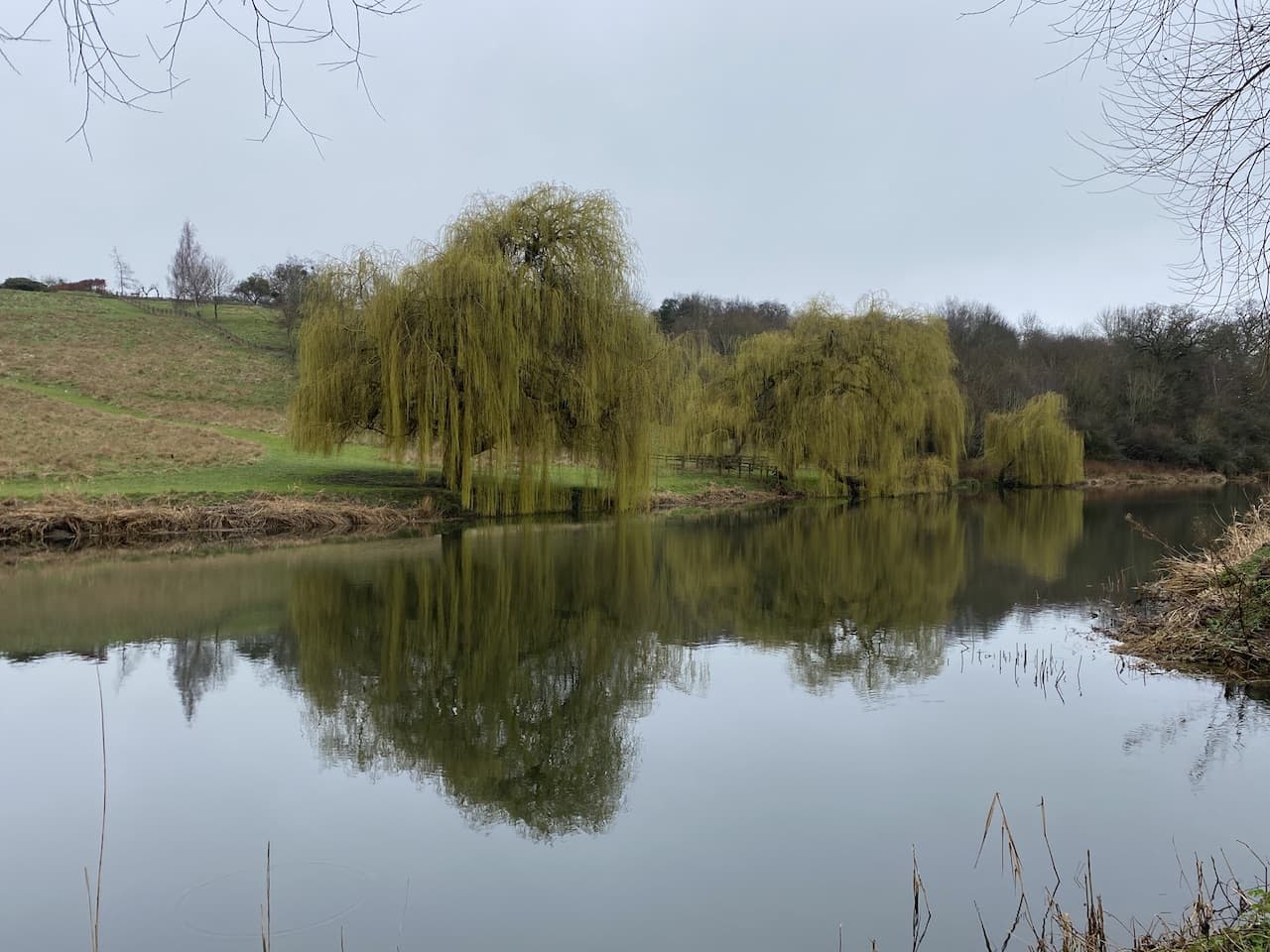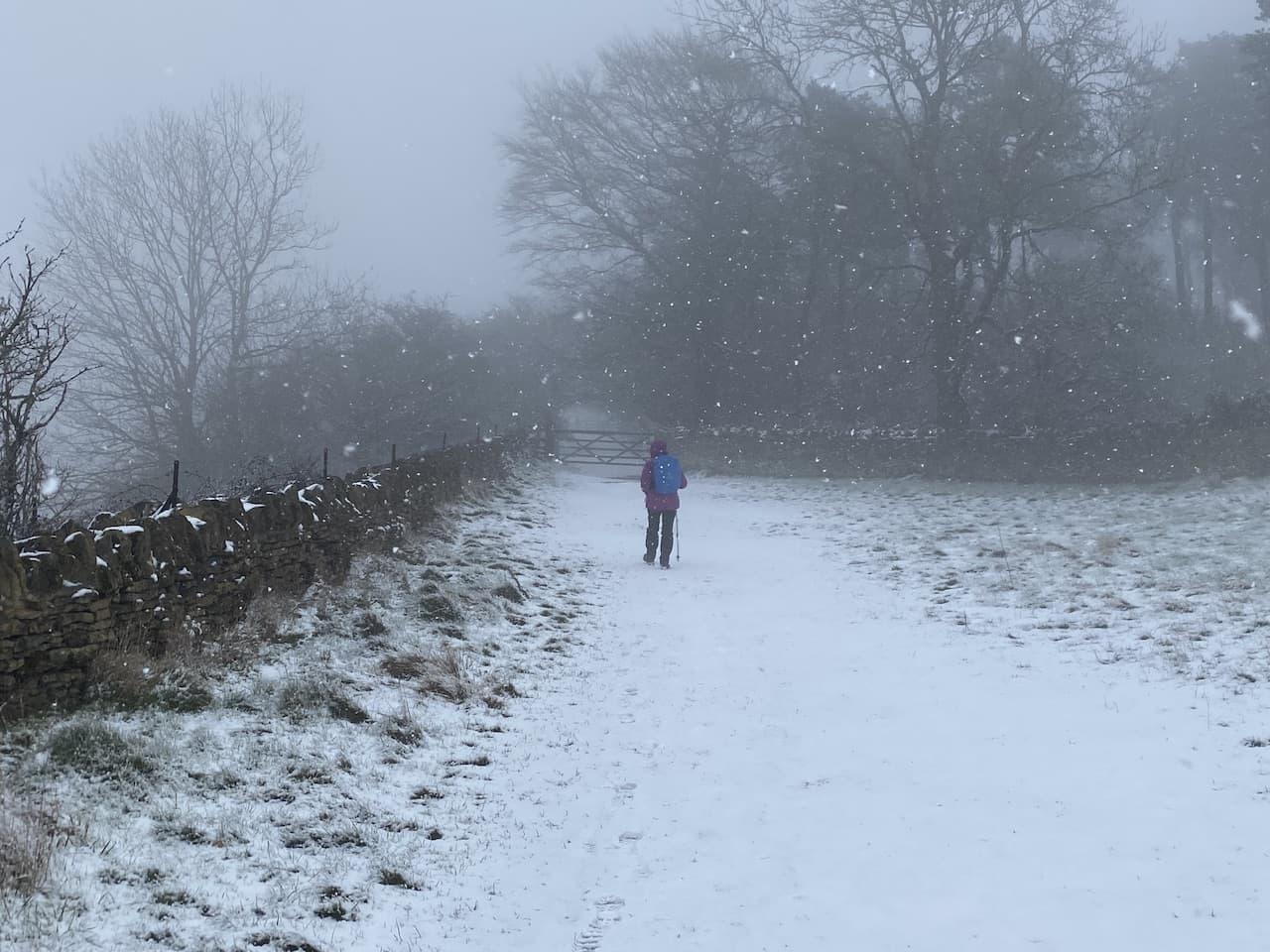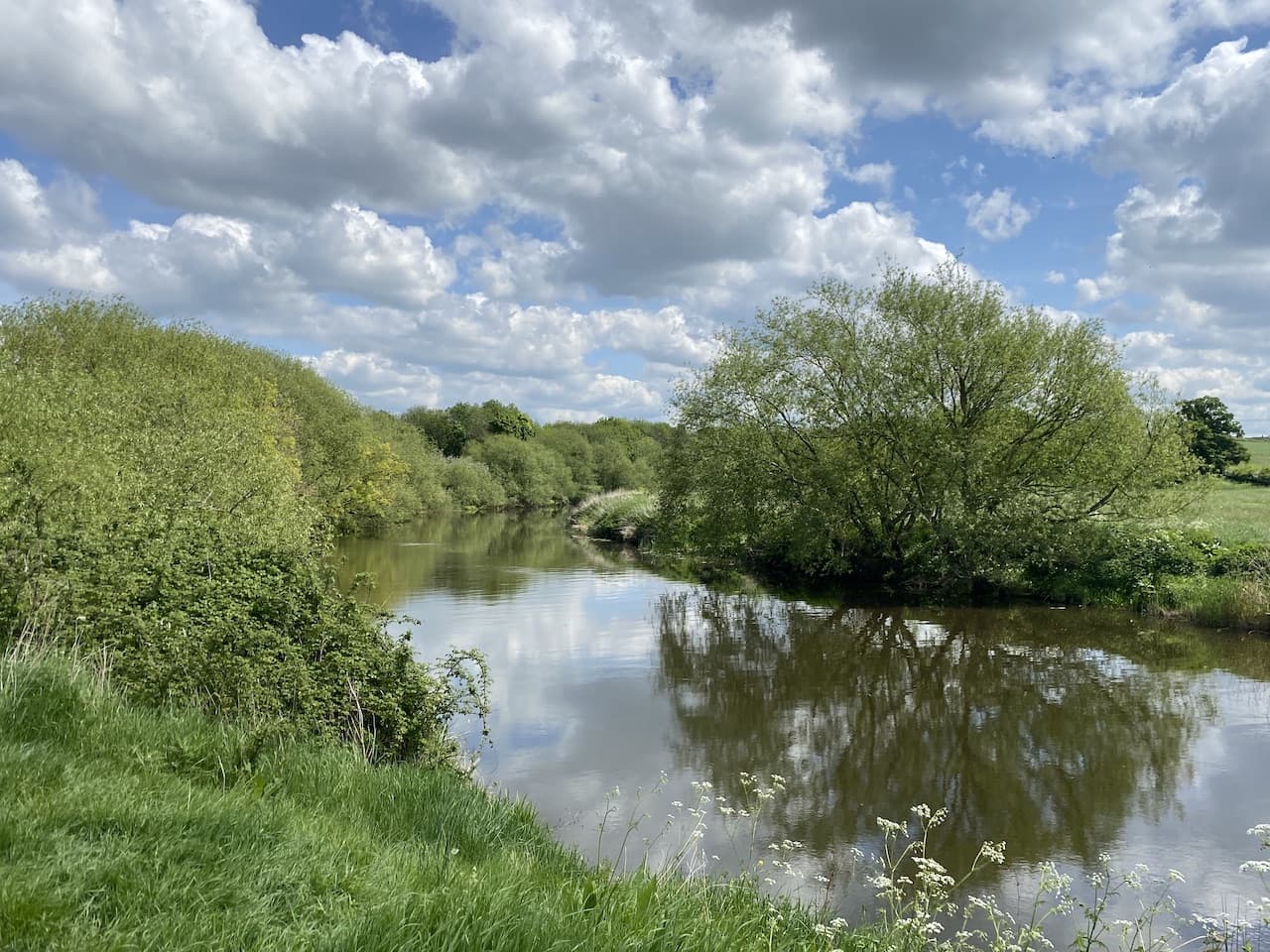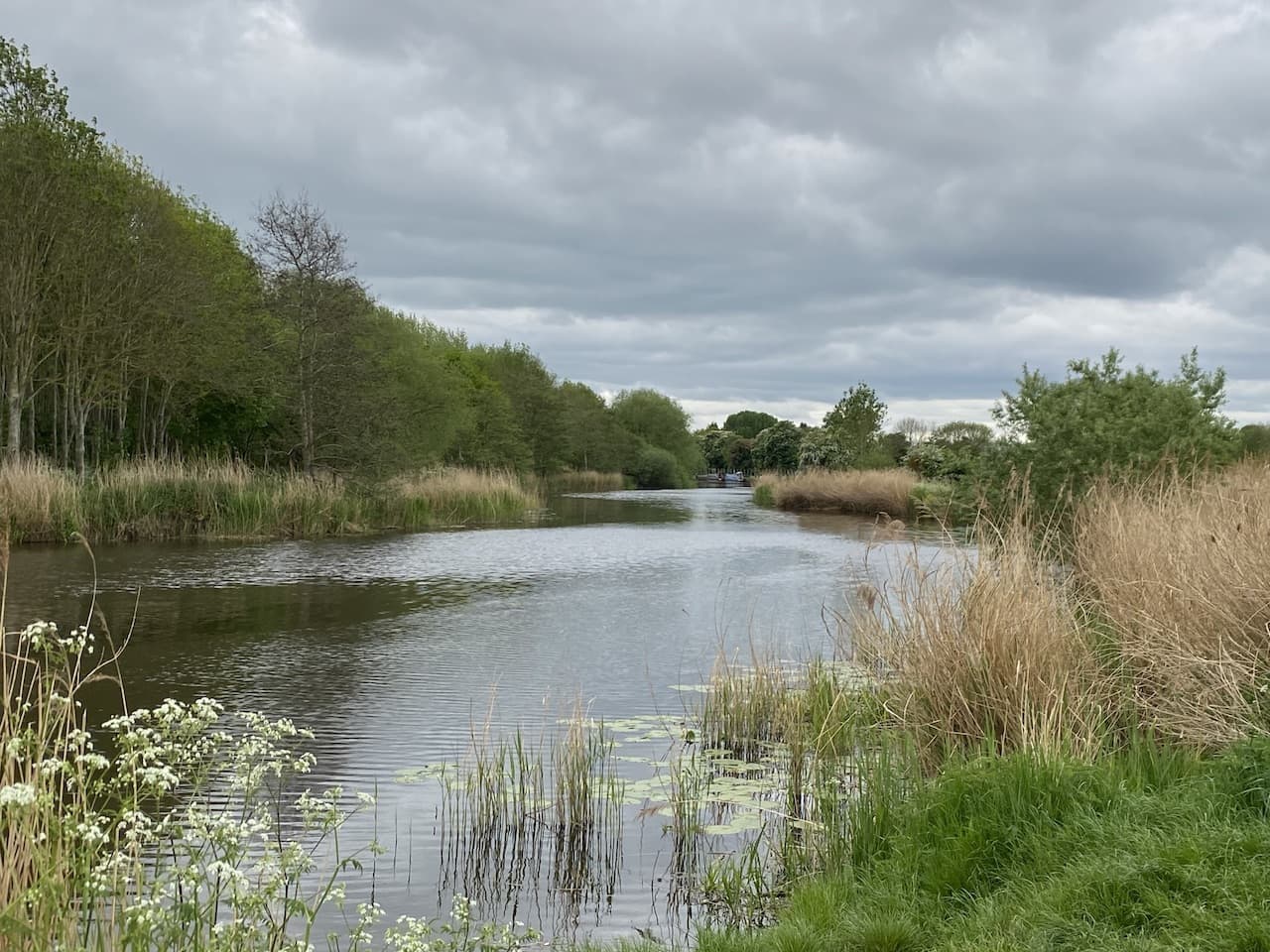After yesterday’s exploits with flooded brooks Lynnie has decided that a wander into Pershore is more attractive than the proposition of venturing far today. I have decided to walk from the caravan site again and plan to do a variation on a walk I did during our last stay at Goodleigh Hill CL.
Leaving by the pedestrian access I walk down to the road and then turn left heading uphill into Pensham Hill and continue until I reach a road junction where I turn left and follow the lane out of the village on the route of Shakespeare’s Avon Way.
Soon the lane turns into a farm track and the route continues between fields with the snow still covering the top of Bredon Hill in front of me.

After passing junctions with two other paths the map shows the footpath going diagonally across a field, however, clearly a route around the edge of the field is well walked so rather than damage crops I follow the field margin to reach a footbridge over a stream.

The path now goes to the right and then left around the edge of a recently ploughed field and then turns to the right to walk a grassy path besides the site of a former golf course currently being turned into a mobile home park.

After going through a kissing gate the path descends to the River Avon where I turn left to head along a broad grassy path beside the river. The river level is still very high, but hopefully there will be no more rain today.

After going through another gate the footpath turns away from the river and heads up a lane towards Great Comberton. At a junction with a road I turn left and walk along the pavement to pass the village War Memorial.

I ignore a road on the left which leads back to Pershore and continue a few hundred yards to where the road bends sharp to the left, here I go through a gate in front of me and follow a path across fields towards Little Comberton.

As I near the village I cross an old ridge and furrow field which is being grazed by sheep. Ridge and furrow fields are a consequence of ploughing with non-reversible ploughs on the same strip of land each year. They are found on land that was ploughed in the Middle Ages, but has not been ploughed since then. It is always a treat to come across one on a walk.

The footpath heads diagonally across the field and enters the village by a stile. This leads to a path between properties and then reaches a road in the village where I turn right towards a crossroads where there is a village information area. This logs the history of the village and serves as a reminder that communities had a whole range of services that no longer exist. The list includes a dairy, bakery, laundry, forge, cheesemaker, post office, shops, petrol station as well as the village policeman and district nurse.
I continue my walk by turning into Manor Lane.

After passing the church I turn left along the pavement and then take a footpath on the right leading into a field.
St Peter’s Church dates back to the 12th century and over the years there have been many additions to the original structure. In 1871 the then rector Reverend William Parker paid for a clock to be installed in the tower which still chimes the hours. In 1886 major restorations were undertaken to create the church as it now stands.

I follow the well-used footpath alongside fields heading east toward Bricklehampton,. Away to my right I get a glimpse of Bricklehampton Hall behind trees. This is an interesting Italianate house built in 1848 which, has now been converted into a care home.

Arriving in Bricklehampton I turn right along a road to reach St Michael’s church and take a footpath through the churchyard. This Norman church was restored in 1875. It has started to drizzle so I decide to press on rather than take a look inside.
Apparently Bricklehampton lays claim to having the longest village name in England that does not repeat any letters.

From the back of the churchyard the path heads east across a field and then alongside horse paddocks to reach a minor road. At the road I turn left and head north to pass Lower Field Barn. As the road bends sharp left at Lower End I take a bridleway on the right.

I stay with this track until I reach a footpath on the left that follows a broad path between fields heading in the direction of Cropvale Farm.

After crossing a bridge the path turns to the left and heads north towards Cropthorne and I soon pass a fine old barn.

Staying with the waymarked route I continue through fields with a stream to my left. This footpath leads to the B4084 which I cross and turn right and then almost immediately take a footpath on the left which goes besides Rowlings Nurseries.

The path goes over a field and then crosses a footbridge and then at a junction of paths I continue north to enter Cropthorne where I turn right along the road and soon pass Holland House which is a Christian retreat.

Further up the road I pass St Michael’s Church. I have previously visited this church which has a number of interesting features, but today Crosby and I are both wet and muddy so I decide not to go in.

From the church I turn left into Neigh Lane which is signposted to Fladbury. I follow this road out of the village and then downhill to reach a junction where I turn left and cross the River Avon.

On the far side of the bridge I join a permissive path on the right crossing meadows besides the river, heading to Fladbury Mill.

The flood waters in the meadow mean I have to take a circuitous route to reach a gate in the corner of the field close to the mill.
The oldest part of Fladbury Mill dates to 1650 when Fladbury Lock and weir was built to make the River Avon navigable. In 1888 electric turbines were installed in the mill which used the power of the river to provide electricity to some houses in the village. By 1900 two turbines were installed and these provided enough electricity for homes and street lighting.
The mill is now in the ownership of the Society for Protected Buildings (SPAB) , it was donated to them in 2021 in a bequest from the then owner David Wynn.

I turn right along the road and pass the mill and then take a brief diversion to look across the flooded river towards Cropthorne Mill. This mill was built in the early 18th century and operated as a mill until the 1930’s.

Continuing through the village I pass the Anchor pub and the Fladbury Pie Shop which is opposite the 1340 St John the Baptist church.

I then pass the Social Club and almost immediately take a footpath on the left leading down Coach Drive. This passes houses and then allotments and follows a concrete driveway heading towards Spring Hill Farm. I’m on the Shakespeare’s Avon Way an eighty-eight mile long distance path following the river Avon from its source at Naseby to its confluence with the River Severn at Tewkesbury.

As the path nears Spring Hill Farm I go to the right past farm buildings and then west to cross a minor road. The waymarked route heads towards a static caravan park. The path is clearly signed and passes caravans dotted around disused gravel pits.

Staying with the waymarkers for Shakespeare’s Avon Way I continue on to skirt around a sewage works and then Lower End Farm, ignoring other footpaths, to reach Wyre Piddle.

The path joins a road where I turn left and wander through the village passing the Anchor Inn to reach the village medieval cross.

I go left at the cross and follow the lane past the small church of St Ann.

The lane heads out of the village, going downhill past the entrance to Wyre Boatyard and then reaching Wyre Mill, this old corn mill dates from the early 1800’s and originally had three wheels. It is now the base of Wyre Mill Club a social club for locals and visiting caravanners and boaters.

After passing the mill and the entrance to a caravan and camping site the path continues on to follow a footpath across meadows heading towards Pershore.

I have a number of options on reaching the edge of Pershore and choose to walk around past the entrance of Pershore Football Club and then wander through a car park besides Asda supermarket to join the High Street where I turn left and continue along the road through the town and then across the River Avon before turning right to return to Goodleigh Hill CL.
You can view this 12.8 mile walk on OS Maps and download the GPX File here.
To follow this walk, you will need Ordnance Survey Explorer Map – 190 – Malvern Hills & Bredon Hill
11th March 2023
© Two Dogs and an Awning (2023)
All information on this site is provided free of charge and in good faith and no liability is accepted in respect of damage, loss or injury which might result from it. To the best of my knowledge the routes are entirely on public rights of way or within areas that are open for public access.
Walking can be hazardous and is done entirely at your own risk. It is your responsibility to check your route and navigate using a map and compass.
